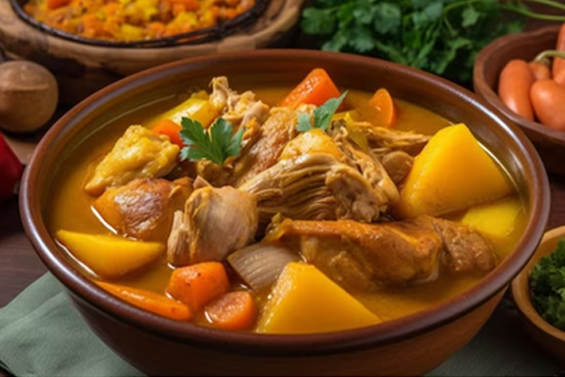Claribel Recipes
Prepare a delicious
Dominican Sancocho
SANCOCHO DOMINICANO (7 CARNES O RES Y POLLO)

Dominican sancocho, a delicious meat and vegetable stew, is undoubtedly the most cherished dish in the Dominican Republic. Although it is often prepared for special occasions, you can also enjoy it any day. Here, we will show you all the ways to prepare this tasty sancocho and how to make it yourself.
¿WHAT IS SANCOCHO?
Let’s start with the name: it can be called sancocho or «salcocho,» both forms are appropriate according to history.
It is important to clarify that sancocho and salcocho are suitable terms, but they are not synonyms.
The similarity in the spelling of these gastronomic terms often causes confusion about their meanings and leads to an incorrect impression that salcocho is the only correct term. Therefore, in the media, we often find phrases like these: «Bernat, who is Domini-Puerto Rican, says he likes to dance merengue and bachata, and eat salcocho» or «Among the savory dishes presented were albóndigas corazón from La Vega, salcocho de gandules…»
When referring to the typical dish of Dominican cuisine, the established term is sancocho, as can be verified in the corresponding entry in the Spanish language dictionary. While the noun salcocho is also valid, it refers more broadly to the preparation of food by boiling it in water and salt (salcochar).
Sancocho is a broth- ased dish with meats and tubers that can be found in various forms in several
countries in Latin America, especially those bordering the Caribbean Sea. There are various types of Colombian sancocho; I have tried Panamanian sancocho de gallina, and there is also Venezuelan and Puerto Rican sancocho. In some regions, it is known by other names such as Sancochado, Sopón, or Olla de Carne.
SANCOCHO INGREDIENTS
This recipe describes how to make seven-meat sancocho, known as Dominican deluxe sancocho.
However, if you prefer a simpler version, you can omit the other meats and add an additional proportional amount of beef or chicken, following the order described in the recipe.
The essential ingredients in sancocho are yuca (cassava), plantain, and auyama (West Indian pumpkin). If you cannot find any of the other ingredients, don’t worry, simply add a proportional amount of yuca, plantain, and auyama instead of the ones you don’t have.
However, there are some almost universal rules: sancocho never includes potatoes, noodles, or tomato sauce.
INGREDIENTS
1 pound of beef for broth (approx. 0.45 kg), cut into small pieces
1 pound of goat meat (approx. 0.45 kg), cut into small pieces
1 pound of pork for broth (approx. 0.45 kg), cut into small pieces
Juice of 2 lemons
1 teaspoon of chopped cilantro or parsley
1/2 teaspoon of dried oregano
1 tablespoon of mashed garlic
1 teaspoon of Claribel Dominican Sazon
1/2 teaspoon of salt (or more, according to your taste), divided into amounts
4 tablespoons of oil
1 pound of chicken (approx. 0.45 kg), cut into small pieces
1 pound of ribs (approx. 0.45 kg), cut into small pieces
1 pound of longaniza (Dominican sausage), cut into small pieces
1 pound of smoked ham bones (approx. 0.45 kg), cut into small pieces
2 corn cobs, 2 of them cut into 1″ (2.5 cm) slices
1/2 pound of yam (approx. 0.23 kg), cut into small pieces
1/2 pound of auyama (West Indian pumpkin) (approx. 0.23 kg), cut into small pieces
1/2 pound of malanga (approx. 0.23 kg), cut into small pieces (optional)
3 green plantains, 2 of them sliced into 1″ (2.5 cm) slices
1/2 pound of yuca (cassava) (approx. 0.23 kg), cut into small pieces
NOTES AND TIPS
The trick to this dish is to add the ingredients according to their cooking time, starting with those that require the most time and ending with those that cook faster. This way, everything will be tender, but the vegetables and meats will not have disintegrated in the broth.
The main meat in sancocho is beef, but as suggested, you can also make it with beef alone or add chicken and other meats according to your preference.
Enjoy this delicious Dominican sancocho highlighted with the unique flavor of Claribel seasoning!
ELABORACIÓN PASO A PASO
VERY SOON
